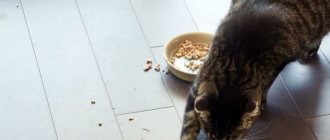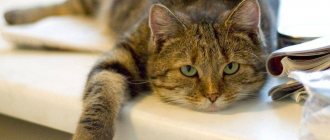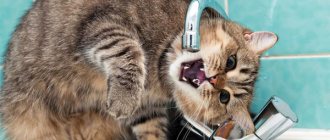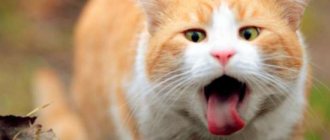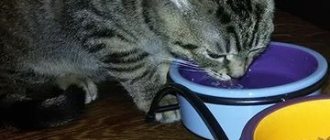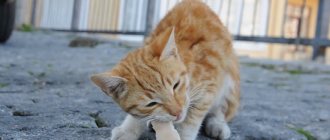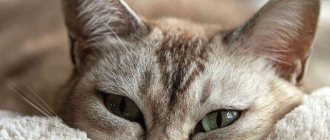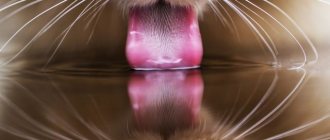All forms of biological life that live on our planet owe their appearance to water. It is no exaggeration to say that all of us, humans, cats, and everyone else, are children of water.
Water gave birth to us, and it continues to support our existence today. Even those creatures that have long left the abyss of water, climbed onto land and even live in deserts, still primarily depend on water. Perhaps only oxygen is more important for most land inhabitants than water. And cats are no exception in this regard.
Water in a cat's diet.
If a cat can live without food for several weeks, then without water they cannot survive even a few days. A cat's body will hold about two liters of water, which is approximately sixty percent of its total body weight. At the same time, we should not forget that she constantly loses fluid along with urine, excrement and exhaled air. We must not forget that cats also sweat and thus also lose fluid through the nose, paw pads, and also with other secretory secretions.
Why water is important for cats
Water is vital for any living creature. It performs important functions in the body:
- regulates body temperature;
- transports nutrients;
- necessary for digestion of food;
- helps remove toxins from the body;
- supports the functions of internal organs;
- ensures the functioning of enzymes;
- participates in the functioning of muscles, joints, eyes;
- maintains tissue elasticity.
Therefore, it is important to have enough of it in the diet. In animals that consume little fluid, concentrated urine is dark yellow in color with a pronounced odor. At the same time, they rarely go to the litter box. Constipation is also an indirect sign of insufficient fluid intake. This can contribute to the formation of sand and stones in the bladder. And also a lack of fluid can lead to weakening of the body, metabolic disorders and decreased immunity. It is necessary that your pet has unlimited access to water around the clock.
What are the dangers of dehydration in a cat?
Recently, furry pets are increasingly suffering from dehydration. Lack of fluid in the body leads to irreversible consequences. A cat may stop drinking water as a result of kidney failure or diabetes. Pets can suffer from dehydration due to an eating disorder. A change in the amount of drinking water intake leads to disruption of metabolic processes.
The dog does not drink water but eats: reasons for how to get a puppy to drink
The main causes of dehydration include:
- change in body temperature;
- prolonged diarrhea and vomiting;
- loss of fluid due to frequent urination;
- lack of drinking bowl;
- heatstroke;
- loss of large amounts of blood;
- fever;
- poisoning;
- staying in a state of shock and stress for a long time;
- infections, viruses, chronic diseases.
Note! Often, large amounts of water are lost during diarrhea. If your cat is diarrhea all day long, she already has some degree of dehydration.
There are three stages of dehydration:
- light. The symptoms are practically unnoticeable; the animal’s nose will be slightly warm;
- average. Sticky and viscous saliva. Dry and pale gums;
- heavy. The cat does not eat, she has lost a lot of weight. She has tachycardia and weak heartbeat, and a dry nose.
The cat does not drink, what could be the reasons?
Domestic cats are descended from desert dwellers, and by nature they drink little. Although they do not have a particular need to drink, staying hydrated is important for their health. The daily fluid requirement depends on age, diet, physical activity, and ambient temperature. The most common reasons:
- You may not like the place if the bowl is in a noisy, crowded room with bright lights, or is located next to the tray.
- Your pet may hold a grudge or be stressed. And as a result, refuse to take not only water, but also food.
- The water may be spoiled, have an unpleasant smell of bleach, detergents, or smell of algae to the cat.
- The animal can receive a significant portion of the liquid from wet food.
- Refusal of fluids may be a consequence of the animal’s malaise or illness, accompanied by poor health, weakness, refusal to eat, and increased body temperature.
Perhaps you don't notice how much your cat actually drinks? Street animals often drink from puddles, while domestic animals find unobvious sources: watering cans, flower vases, buckets, toilets, and often drink from the owner’s cups.
Hello saucer!
A small kitten can be compared to a human child, although this comparison is not very correct. But why is such an allegory given? We gradually accustom our children to other foods, but at the same time he continues to eat mother’s milk or special formulas. You should also behave with small kittens. But if there is no cat, and the baby is still small, not even 3 weeks old, then you will need to feed the kitten milk from a pipette or even from a bottle.
Features of nutrition during the transition period
It is very important to introduce any complementary foods gradually. First, make a simple liquid semolina porridge with diluted milk; no sugar should be added.
After the kittens' stool has returned to normal, you can make liquid milk porridge from rice, rolled oats and buckwheat. In parallel with such food, you can also give low-fat cottage cheese. We must remember that everything that kittens eat will not be eaten right away, so you need to put very little food on the plate.
To eat, kittens can approach the bowl very often during the day, but the frequency should not exceed 6 times. Closer to the age of two months, babies need to be taught to eat more solid foods: boiled meat and fish, sometimes you can give them fresh, but be sure to make sure that they don’t get large bones. The pieces of food should be small; sometimes you can mix pieces of fish with any porridge cooked in water. It is best to use ready-made canned food for young children, but you need to carefully monitor them when they begin to eat such food.
How to train to a bowl?
Now we come to the most important question: when and how to accustom a kitten to a saucer and how long this procedure will take. As mentioned earlier, kittens begin to be interested in the saucer at three weeks of age, or rather, they show curiosity about the food of adult cats. Therefore, this particular age is considered one of the best for teaching a baby to eat from a plate.
At first, the baby will constantly snort and sneeze with milk bubbles. This is due to the fact that he is just beginning to comprehend the science of lapping, because quite recently he only sucked his mother’s milk. You can also sometimes see him reaching directly into the bowl with his paws; this must be stopped immediately.
To do this, you need to take it out of there, wipe its paws with a napkin and place it near the bowl. The next time he gets ready to climb into the saucer again, you need to hold him back. This way you can teach the kitten that limbs should not be in the food.
How much water should a cat drink daily?
An adult, healthy individual needs to consume approximately 40-50 milliliters of fluid per kilogram of body weight daily. The amount of moisture in the feed is also an important point. For example, a pet weighing 4.5 kilograms requires approximately 200 ml of liquid. If a cat eats 170 grams of wet food daily (moisture content 80%), it covers more than half of the daily water requirement, receiving 135 ml of liquid with the food. If he eats only 70 grams of dry food (moisture content 9%), he needs to drink another 180 ml per day. The activity level of pets should be taken into account. The more active your pet is, the more fluid it needs. Also, if the air temperature outside or indoors is above 20 degrees, the need for fluid consumption increases. It is worth noting that sometimes a different drinking regime may be required. So, for certain diseases or after operations, you must strictly follow the veterinarian’s recommendations. Stress factors, for example, a change of place of residence, unknown people at home, a neighbor's cat, affect the behavior of four-legged friends. Often cats drink less in such situations. Let her get used to the new life situation, observe her behavior. The required amount of fluid for the body also depends on age. A kitten's young, growing body requires more fluid. And in old age, this need decreases. It is completely normal for an older cat to drink less than normal.
Secretory diarrhea in more detail
The mechanism of development of this type of gastrointestinal disorder is as follows:
- Increased movement of electrolytes into the intestinal lumen
- Electrolytes pull water with them, and watery diarrhea begins
Reasons for the development of pathology:
- Infection – foodborne illnesses, cholera, staphylococcus, some strains of E. coli, bacteria of the species Yersinia enterocolitica
- Damage from toxic substances - arsenic, phosphorus compounds, insecticides
- Genetic diseases - folic acid malabsorption
- Some cancers - pancreatic tumors, gastrinoma, medullary thyroid cancer
- Taking certain laxatives - castor oil, buckthorn bark, rhubarb
With this type of diarrhea, all pathological processes are concentrated in the small intestine.
How to train a cat to drink more
Cats are unique and so are their drinking habits. It is impossible to force a pet to do anything, but there are tricks that can be used to influence the animal’s habits. At the same time, it is much more difficult to retrain an adult. Try different options and observe to find out your preferences. Maybe Fluffy prefers running tap water? This means you should think about purchasing a special drinking fountain. It consists of a container and a small pump that ensures constant movement of water and saturation with oxygen. Owners notice that cats are more willing to drink from certain bowls. Some people don't like the whiskers to touch the edge of the bowl and prefer wide, shallow bowls. Others like to drink from large bowls, containers where they can dip their paws, like in a pond. The material of the bowl plays an equally important role. It’s worth experimenting and finding out what you like best: a bowl made of clear glass, ceramics, metal or plastic. You can try changing the location of the bowl. If you can find the right spot, cats will be more willing to drink. Pets may not like it if bowls of water and food are placed nearby and do not like to share bowls with other animals. Many people will disdain to drink next to the tray. Many people like to have several bowls of water placed around the house; they are curious animals, keenly interested in the unusual and new. Using these simple tips, you will find her favorite place. Cats love fresh water, so it needs to be changed daily. But there are exceptions to the rules - some prefer stagnant water. To increase your pet's interest in water, add a couple of drops of cream, milk or meat juice. Please note that you should not give milk and cream in its “pure” form, they contain milk sugar, which causes diarrhea in most cats. By the way, you can prepare meat juice in the form of ice cubes to add flavor. But don't let your cat drink ice water! It should be at room temperature. Animals that prefer clean, fresh water may be disturbed by the taste or smell of tap water. In this case, drinking water purification filters will come to the rescue or use bottled still water. There are no beneficial substances in boiled water, so it is better to give preference to raw water. One way to increase the amount of fluid consumed is to add it to the food. Try soaking dry food or adding a small amount of liquid to wet food. Several small meals daily, consistent with cats' natural feeding behavior. With each meal they drink a little water, since the secreted digestive juices cause a feeling of thirst. It is preferable to choose the frequency of feeding together with your veterinarian, taking into account, for example, the results of a urine test.
Organize the right place for a watering hole
Sometimes a cat drinks little water only because the water bowl is in the wrong place and there is no alternative.
Water should not be near food
The most common misconception among owners is to place a bowl of food and a bowl of water next to each other, or even use a double bowl. Drinking where they have eaten is not typical for cats; in nature, a watering hole is always located at a distance from the hunting area. And this instinct is still relevant: if a pellet of food or a piece of meat falls into a bowl of water, it will instantly deteriorate, becoming undrinkable. How quickly the owner will discover the problem is a big question.
Water should not stand near the tray
No comment here - neither water nor food should be near the cat's litter box. Cats are clean animals; they carefully bury their excrement, prefer to use a litter tray with fresh litter, and are disdainful of eating near their own litter box.
It's funny, but a human toilet may seem like a good source of fresh water to a cat - far from the kitchen, in a secluded place, on a hill. The danger is that the cat can be poisoned by detergents due to the owner’s oversight.
Image is nothing, thirst is everything!
There must be several sources of water
Cats are extremely sensitive to hunger, but can ignore thirst for a long time. Therefore, there should be several bowls, taking into account the size of your home - for a small apartment this is at least three watering places.
The water should be in the path of the cat's usual route. Observe where your pet likes to rest and play (woke up, drank and only then ran to eat).
A cat's laziness knows no bounds, just take it for granted that your cat will not specifically go looking for water to drink.
Water on a hill
In the wild, the higher the water, the cleaner it is. Cats strive “to the source of the river,” ignoring the water that is in a flat bowl on the floor. Sometimes it is enough to place a deep bowl on a raised surface (window sill, table) to get your pet interested in water. Many cats like to drink from the tap not because there is running water. The sink is just high enough.
Oh, water, good luck. Whatever I don’t finish, I’ll spill
If you place a drinking fountain on the floor, it will be less attractive than a water tap. It is better to place high containers on the floor: a bucket, basin, pan.
Bobtail drinks from a bucket
Main symptoms
Watery stool is common in children
When visiting a doctor, it is important to be honest about your symptoms. The process and result of treatment depends on this. Typical signs of secretory diarrhea:
- Liquid, partial, watery bowel movements – from 5 to 10 liters per day
- No noticeable stench
- Almost complete absence of signs of intoxication
- Pain syndrome is not observed or is mild
- The temperature rises slightly - to a maximum of 37.8 °C
- No false urge to defecate
- Fasting does not help stop diarrhea
- There are high levels of sodium chloride in the stool - the composition is similar to blood plasma
- There are no leukocytes or blood clots in the stool
- Low levels of potassium ions in the blood - because of this, the patient may experience seizures
What happens during a doctor's examination
The outcome of treatment for secretory diarrhea depends on the correct diagnosis. Diagnostics is as follows:
- Questioning the patient - the presence and nature of complaints, duration of diarrhea
- Examination of the patient - special attention should be paid to the degree of dehydration and symptoms of hypokalemia - convulsions, muscle roll syndrome
- Proctological examination - this will reveal tumor processes, fissures or fistulas of the anus
- Study of stool tests - coprogram, parasite eggs, stool occult blood test, bacterial culture
After the research and diagnosis, the doctor decides whether to hospitalize the patient. With secretory diarrhea, no signs of severe intestinal infection, or mild dehydration, adult patients can be treated at home. In all other cases, including pregnant women, treatment in a hospital setting is indicated.


